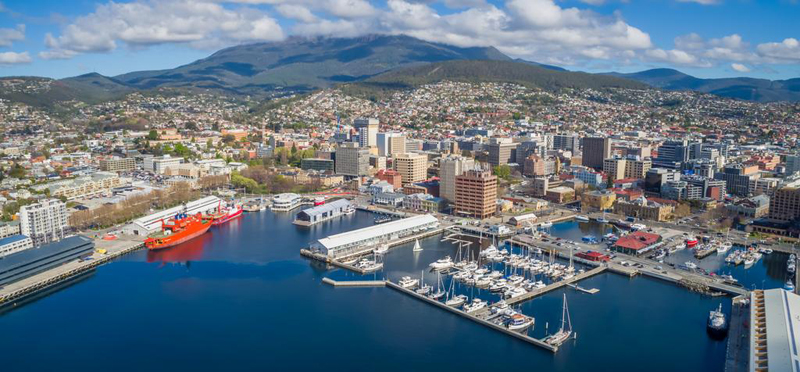Hobart is especially vulnerable to attack by wildfire. Here’s a new idea to help make it safer.

David Bowman’s idea is to create a green barrier between the bush and the city.
Residents of Hobart don’t need to be reminded of this city’s unique mix of spectacular scenery, old settlement and vibrant, diverse population. We see it daily, and we love it.
Part of the city’s appeal is its shape. Greater Hobart isn’t your regular metropolis, spreading in all directions from the centre, but a long, narrow strip between mountain and sea. White caps on the estuary and the mountain’s forests and scree slopes are never far away.
About 100,000 lived in the metropolitan area when the 1967 fires roared through. Now around 230,000 are squeezed into that same narrow corridor, augmented by expansion into adjacent municipalities and – crucially – deeper into the foothills of Mt Wellington.
Hobartians’ coastal views and easy bushland access are the envy of residents of other Australian capitals. But that long bushland boundary makes them uniquely vulnerable to wildfire attack.
The narrowness of the residential area also limits travel route options, a point not lost on commuters stuck in last week’s mega-snarl. Nor is it lost on residents of Hobart’s forest-fringe suburbs.
A late-summer Fern Tree fire-season briefing jointly organised by Hobart City and the Tasmania Fire Service was memorable for its candid discussion of options available to such fringe-dwellers facing a rising fire risk with drier, warmer summers.
Losing your home isn’t as bad as losing your life, but it’s pretty bad, and with limited route options you could still die if you leave your escape too late. There’s also the matter of rising insurance premiums for homes near the forest – a powder-keg ready to explode on any warm, breezy day.
As David Bowman sees it, every Hobart resident should sit up and take notice. Professor of environmental change biology at the University of Tasmania, Bowman has made a career out of studying Australian bushfires. Hobart’s geography, he says, makes the whole city vulnerable.
At our community briefing Bowman raised the idea, though not endorsing it himself, that we fringe-dwellers should simply get out and stay out, leaving the bush to its own devices. That raises the prospect of relocating large numbers of households, with more to follow as the bush moves in.
There is the alternative of planned year-on-year understory burning, or prescribed burning, recommended by the royal commission into Victoria’s devastating 2009 fires.
Prescribed burning is currently used in both Victoria and Tasmania, but is not without its critics.
In a paper published late last year in the International Journal of Wildland Fire, Bowman and two other Tasmanian scientists, James Furlaud and Grant Williamson, described the results of using computer models to simulate tens of thousands of wildfires across Tasmania.
They found that prescribed burning won’t really do the job unless it covers a third of the state’s area each and every year. Less extensive burning was found to be of little value except when it’s done next to homes. But all burning has public health consequences and carries risk of fires escaping.
There’s another issue, to do with a warming climate. California’s 2017 fire season was fully six months long, with massive blazes as late as mid-December. Our fire season is lengthening too, increasingly limiting the window of opportunity for prescribed burning.
Where does that leave us? Believing that the urban fringe should not simply be abandoned, Bowman and his colleagues have come up with another idea. But it will demand a big shift in the way we view our natural environment.
They call their idea “green firebreaks” and describe it as “careful landscape design at the local scale”. It sounds uncontroversial until you unpack what has to be done to implement it.
Green firebreaks as Bowman describes them are areas around the upper perimeter of Hobart’s settled areas which have been largely cleared and replaced with thinned bush, less flammable tree plantings and grassy areas grazed by native animals. They would be serviced with piped water. They would be quite wide, preferably hundreds of metres to allow a reasonable chance of defending nearby homes.
They would be visible at a distance, but after a few seasons their visual impact would be slight – considerably less than a burnt firebreak or a forestry clear-fell.
Perhaps we’re headed back to the future. Early European explorers recorded Aboriginal people across Australia using fire to maintain open forest lands, and as recently as the 1960s settled mountain slopes behind Hobart had much more cleared land than we see today.
Doubtless Bowman’s thoughts will raise some eyebrows. We see trees as needing protection, as indeed they do, but we have to acknowledge the dangers that an unbroken eucalypt canopy poses for settled areas. This is an idea whose time has come.
WHERE is climate change in the State election campaign? Representatives of the three main parties will seek to answer that question tonight in a public forum at Scots Memorial Church Hall, 29 Bathurst Street, Hobart starting at 7 pm.
